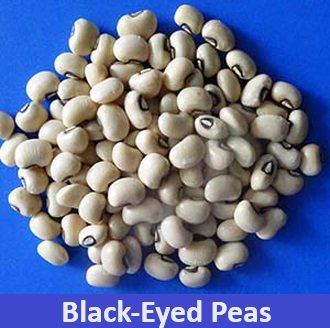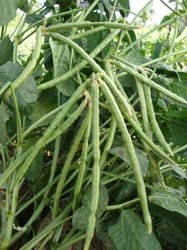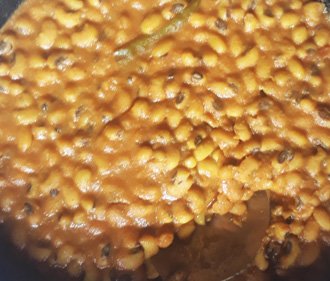Cowpeas (Black-eyed peas) Nutrition facts
Cowpeas, also known as southern peas or field peas, are small, kidney-shaped beans belonging to the legume family. They hold a special place in Southern cuisine in the US, featuring prominently in various specialty dishes. Despite their colloquial names, botanically, these seeds are categorized as a type of field bean and are not part of the pea family.
From a botanical perspective, cowpeas are classified under the Fabaceae family, within the genus Vigna.
Scientific name: Vigna unguiculata (L.) Walp.
 |
Cowpeas, resilient bush beans, thrive in various soil conditions, particularly sandy ones, and can withstand drought. They produce petite flowers in shades of white, cream, or purple arranged in racemes, which eventually give way to elongated pods containing 6-15 seeds each.
 |
| Blackeye pea plant. |
Varieties of cowpeas are cultivated based on their seed type and color, including:
Black-eye and purple-eye: These beans are kidney-shaped with blunt ends. Their cream-white skin exhibits white hilum surrounded by black, pink, or light-red stains. They are easily shelled and produce attractive, mild-flavored peas suitable for processing.
Brown eyed: Featuring a white hilum surrounded by brown skin, these cowpeas come in pods ranging from green to purple and various lengths.
Crowder: Characterized by closely crowded seeds within pods, these cowpeas tend to be globular in shape.
Cream beans: These cowpeas have cream-colored seeds with inconspicuous hilum, lacking a noticeable "eye."
Health Benefits of Cowpeas
Cowpeas, in all their varieties, stand out as exceptional sources of vegetarian protein. With 336 calories per 100 grams of dry seeds, they provide a substantial 23.52 grams, equivalent to 42% of the recommended daily value of protein.
Black-eyed peas, akin to other field beans, boast significant levels of dietary fiber, offering 10.6 grams or 28% of the daily fiber requirement per 100 grams. This fiber acts as a bulking agent in the digestive system, safeguarding the colon mucosa by reducing exposure to harmful substances and binding to potential cancer-causing chemicals.
Dietary fiber has demonstrated efficacy in lowering blood cholesterol levels by reducing the reabsorption of cholesterol-binding bile acids in the colon.
Cowpeas contain a moderate amount of the O-methylated isoflavone compound, Biochanin-A, with 0.58 mg per 100 grams. Biochanin-A, categorized as a plant estrogen, is implicated in anti-cancer dietary strategies according to research findings.
Notably, black-eyed peas serve as gluten-free options, making them particularly favored for individuals with gluten allergies and celiac disease.
Rich in B-complex vitamins such as folates, thiamin, pantothenic acid, pyridoxine, riboflavin, and niacin, cowpeas play a vital role as co-factors in various enzymatic processes involved in carbohydrate, protein, and fat metabolism.
Among field beans, cowpeas reign supreme in folate content, providing a remarkable 633 micrograms, equivalent to 158% of the daily recommended intake. Folate, alongside vitamin B-12, is crucial for DNA synthesis and cell division, potentially averting neural tube defects during pregnancy if consumed adequately.
Additionally, cowpeas serve as exceptional sources of essential minerals. A 100-gram serving of dry beans contains significant percentages of copper (94%), iron (107%), manganese (66%), phosphorus (61%), selenium (16%), calcium (11%), and zinc (31%).
Copper and iron, pivotal in blood cell production, are abundantly present in black-eyed peas, making them valuable dietary components, particularly in regions combating anemia.
Furthermore, black-eyed peas boast high potassium levels, with 100 grams providing 1112 milligrams, covering 24% of the daily requirement. Potassium's role in intracellular and extracellular fluid balance counters the adverse effects of sodium on cardiac function, contributing to blood pressure regulation.
| Principle | Nutrient Value | Percent of RDA |
|---|---|---|
| Energy | 336 Kcal | 17% |
| Carbohydrates | 60.03 g | 46% |
| Protein | 23.52 g | 42% |
| Total Fat | 1.26 g | 6% |
| Cholesterol | 0 mg | 0% |
| Dietary Fiber | 10.6 g | 28% |
| Vitamins | ||
| Folates | 633 μg | 158% |
| Niacin | 2.075 mg | 13% |
| Pantothenic acid | 1.496 mg | 30% |
| Pyridoxine | 0.357 mg | 27% |
| Riboflavin | 0.226 mg | 17% |
| Thiamin | 0.853 mg | 71% |
| Vitamin-C | 1.5 mg | 2.5% |
| Electrolytes | ||
| Sodium | 16 mg | 1% |
| Potassium | 1112 mg | 24% |
| Minerals | ||
| Calcium | 110 mg | 11% |
| Copper | 0.845 μg | 94% |
| Iron | 8.27 mg | 107% |
| Magnesium | 184 mg | 46% |
| Manganese | 1.528 mg | 66% |
| Phosphorus | 424 mg | 61% |
| Selenium | 9 μg | 16% |
| Zinc | 3.37 mg | 31% |
| Phyto-nutrients | ||
| Biochanin-A | 0.58 mg |
Selection and storage
Immature, whole, and shelled cowpeas are suitable for consumption as vegetables. Canned and whole dry beans are conveniently accessible at grocery stores and markets.
When selecting, opt for completely dried and intact seeds packaged in bags. Avoid beans that show signs of insect damage, slits, breakage, or mold.
For storage, transfer whole dry beans to plastic or steel containers, keeping them away from moisture and heat. Whole beans can maintain their quality for several months.
Treat green cowpea pods and shelled beans akin to green beans
, following the same handling guidelines.Preparation and serving methods
 |
| Black eyed pea stew. |
The raw, green pods of black-eyed peas are edible before they are fully mature and are often served as a green vegetable. The leaves, shoots and tendrils are also used like spinach.
Although soaking is not mandatory for cowpeas, it quickens overall cooking time, removes anti-nutritional compounds, and enriches the flavor. Soaking in cold water for 3-4 hours is sufficient. Whole beans may take about one hour to cook. Pressure cook for 10 min with soaking; 10-20 min without soaking. Avoid overcooking which turns them into mashed.
Black-eyed peas can also be used in soups and salads, cooked in patties, or slow-cooked. They are made into a puree or sprouted.
The young, green pods of black-eyed peas are edible even before reaching full maturity and are commonly enjoyed as a green vegetable. Similarly, their leaves, shoots, and tendrils serve as alternatives to spinach.
While soaking isn't obligatory for cowpeas, it accelerates cooking time, eliminates anti-nutritional compounds, and enhances flavor. A soak in cold water for 3-4 hours suffices. Whole beans typically require around an hour to cook, but pressure cooking for 10 minutes after soaking or 10-20 minutes without soaking is also effective. Caution should be taken to avoid overcooking, which can result in a mushy texture.
Black-eyed peas are versatile and can be incorporated into soups, salads, patties, or slow-cooked dishes. They can be pureed or sprouted as well.
Here are some serving tips:
In Southern cuisine, cowpeas are essential in the traditional New Year's Day dish known as southern black-eyed pea recipe, typically cooked with ham hocks, onion, pepper, and garnished with parsley.
Across West Africa, soaked and hulled black-eyed peas are transformed into a variety of tantalizing dishes. Cowpea fritters, known as akara, are popular, often served with Tomato Sauce (Akaraje in Brazil, sometimes with shrimp and okra filling), while red cowpeas stew is a beloved classic in Nigeria and Ghana.
In Turkey, cowpeas are cooked with mustard greens and urfa pepper, creating a flavorful dish typically served alongside rice.
Middle Eastern cuisine incorporates baked black-eyed beans into dishes like Bean Salad, adding a unique touch to the culinary landscape.
In the Indian subcontinent, known as lobia, cowpeas are a dietary staple, featuring prominently in stews and sabzi, reflecting the diverse culinary traditions of India and Pakistan.
Safety profile
Unlike Adzuki kidney beans, consuming raw cowpeas does not result in poisoning from phyto-hemagglutinin (lectin) toxin, a condition that can lead to the clumping of red blood cells in humans. However, boiling cowpeas neutralizes other antinutrient compounds like trypsin and improves digestibility. (Medical disclaimer).
You may also like to read≻≻-
Adzuki beans Nutrition facts and health benefits.
Chickpeas Nutrition facts and health benefits.
Navy beans Nutrition facts and health benefits.
fava beans Nutrition facts and health benefits.
≻≻-Back to Legumes from Cowpeas. Visit here for an impressive list of vegetables with complete illustrations of their nutrition facts and health benefits.
≻≻-Back to Home page.
Further Reading:
Fieldbean- Agriculture, Forestry & Fisheries-pdf.